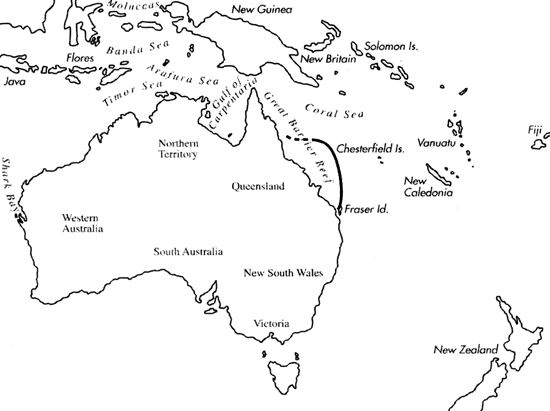Range: Queensland, Australia, from Bundaberg area to the southern part of Great Barrier Reef.
Description: Moderately small to medium-sized, moderately solid to solid. Last whorl conical to ventricosely conical, outline convex adapically and less so to straight toward base; left side constricted just above base. In form albellus (Pl. 58, Figs. 13-15), last whorl generally less ventricose and more straight-sided than in typical form. Shoulder angulate, sometimes subangulate in large specimens. Spire of low to moderate height, generally higher in typical form than in form albellus; outline concave to almost straight. Larval shell of 1.75-2 whorls, maximum diameter 1.2-1.3 mm. First 2-7 postnuclear whorls tuberculate; in similarly sized specimens, typical form with slightly more postnuclear whorls than form albellus (L 45 mm: ca. 9.25 vs. ca. 8.5 whorls). Teleoconch sutural ramps flat, with 1-2 increasing to 4-7 spiral grooves. Last whorl with spiral ribs, ribbons and threads extending from base to shoulder in variable sequence; grooves between axially striate, wider towards base. In form albellus, sculpture of last whorl usually less prominent, with ribs concentrated near base and below shoulder and ribbons between; large specimens sometimes nearly smooth adapically.
| Shell Morphometry | ||
|---|---|---|
| L | 30-55 mm | |
| RW | 0.11-0.37 g/mm | |
| RD | 0.57-0.68 | |
| (0.55 - 0.66 form albellus) | ||
| PMD | 0.80-0.88 | |
| RSH | 0.10-0.22 | |
| (0.07 - 0.16 form albellus) | ||
Ground colour white. Last whorl with brown spots, streaks, flames and blotches fusing into 3 interrupted to solid spiral bands, just below shoulder and above as well as below centre; specimens of typical form may have additional spiral rows of small brown spots and narrow bars. Shells nearly without any pattern elements intergrade with shells that have almost solid brown last whorls. In form albellus, pattern elements usually sparse and less prominent than in typical form, white shells more frequent. Larval whorls white. Postnuclear sutural ramps with brown radial markings partially extending beyond outer margins and matching last whorl pattern in prominence. Aperture white.
Habitat and Habits: In 80-225 m. At the type locality, form albellus was dredged from blue-grey mud and shell substrate.
Discussion: C. limpusi is similar to C. minnamurra, C. colmani and C. lizardensis. For comparison with the latter species, see the Discussion of C. lizardensis. C. minnamurra differs in its usually broader last whorl (RD 0.64-0.72), non-tuberculate early postnuclear whorls and in its generally fewer larval whorls (1.5-1.75 vs. 1.75-2). In addition, its spire outline is convex to straight instead of concave to almost straight. C. colmani can be distinguished by its generally broader last whorl (RD 0.62-0.73), narrower larval shell (1.05-1.15 mm) mostly more uniform spiral sculpture of the last whorl and by its more axially oriented last whorl pattern. Subadult shells are rather pyriform in C. Colmani but conical in C. limpusi. Strongly sculptured specimens of C. colmani are sometimes nearly inseparable from C. limpusi. The typical form and form albellus of C. limpusi occur sympatrically and have almost identical bathymetric ranges. Although C. albellus was originally considered a separate species, additional material from several localities in the Swain Reefs includes shells intermediate in shape, sculpture and pattern between it and C. limpusi. We therefore provisionally regard C. albellus and C. limpusi as conspecific and determine the name C. limpusi as the species name (Art. 24 (a), ICZN).

C. limpusi range map
This section contains verbatim reproductions of the accounts of 316 species of Conus from the Indo-Pacific region, from Manual of the Living Conidae, by Röckel, Korn and Kohn (1995). They are reproduced with the kind permission of the present publisher, Conchbooks.
All plates and figures referred to in the text are also in Röckel, Korn & Kohn, 1995. Manual of the Living Conidae Vol. 1: Indo-Pacific Region.
The range maps have been modified so that each species account has it own map, rather than one map that showed the ranges of several species in the original work. This was necessary because each species account is on a separate page on the website and not confined to the order of accounts in the book.